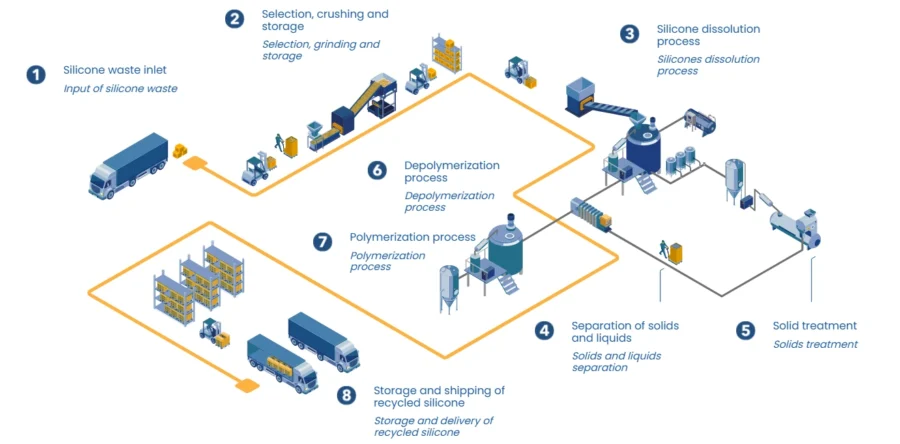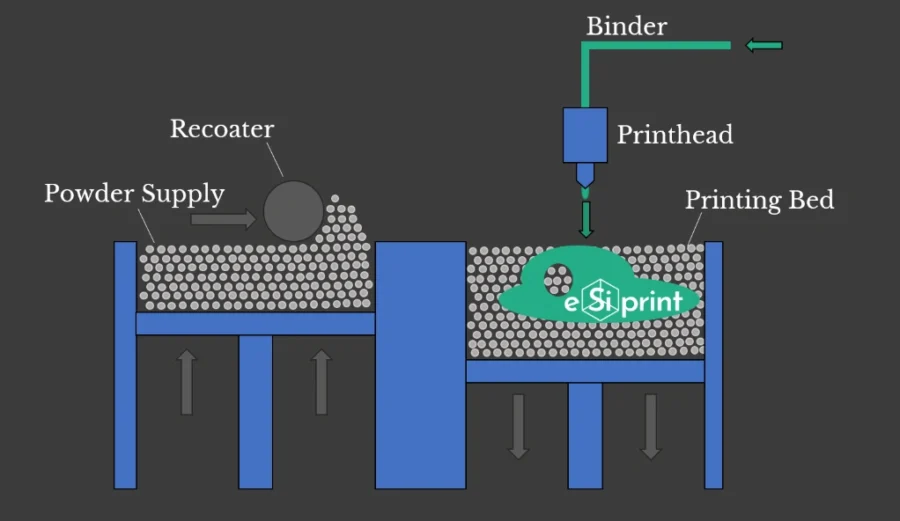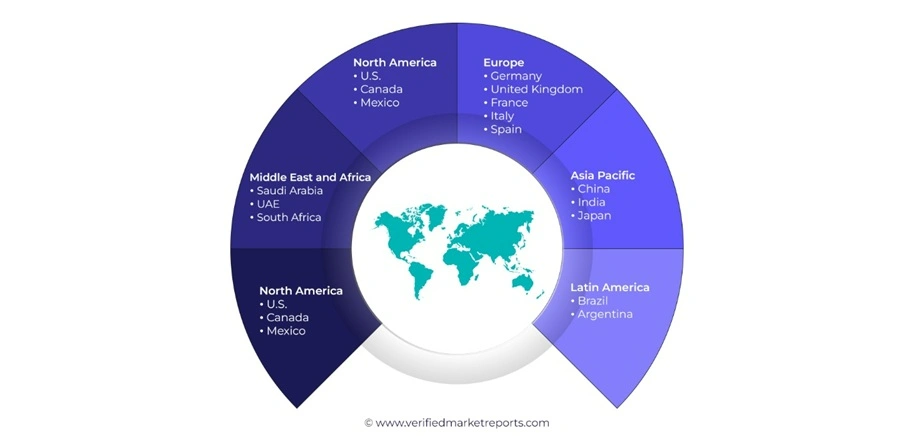Accelerate Productivity in 2025
Reignite Growth Despite the Global Slowdown
Executive Summary: What are the Top 10 Silicone Trends in 2026?
- Sustainability & Circular Economy: Silicone recycling market projected to reach USD 4.2 billion by 2033 at a 10.2% compound annual growth rate (CAGR). Global silicone production is expected to exceed 3 million metric tons by 2025.
- Silicone Sealants & Adhesives: Market expected to reach USD 15 billion by 2035 at a CAGR of 6.6%. Advances focus on bio-based, volatile organic compounds (VOC)-free sealants and energy-efficient adhesives.
- Flexible Electronics: Liquid silicone rubber (LSR) market will expand to USD 10.41 billion by 2035 at 3.8% CAGR, with medical-grade LSR accounting for 34% of the segment. The demand is driven by wearables, automotive sensors, and implantable medical devices.
- Silicone 3D Printing: Scalability faces hurdles from high resin costs, limited material compatibility, and slow printing speeds. Advancements in resin chemistry, thermal cross-linking, and multi-material printing improve resolution, reduce waste, and enable precision manufacturing.
- Material Innovations: The silicone polyether copolymers market is projected to reach USD 2.8 billion by 2033 at a 7.5% CAGR. Emerging material innovations include biobased silicones, self-healing formulations, thermally conductive LSR, and self-adhesive silicones.
- Silicone Gels: Market expected to reach USD 2.79 billion by 2032 at an 8.35% CAGR. North America will hold 40% of the global scar gel market, while Asia-Pacific leads growth.
- AI Integration: AI in silicone manufacturing optimizes extrusion, molding, and curing, enabling real-time process control and improving batch consistency. Digital twins simulate production, reducing pilot trial costs, while AI-powered defect detection ensures quality in medical-grade silicones.
- Silicone Fluids & Emulsions: The global silicone fluids market is projected to reach USD 7.66 billion by 2030 at a 5.29% CAGR. The Asia-Pacific region leads demand growth due to electronics and automotive manufacturing. Innovations focus on UV protection, antibacterial coatings, and eco-friendly hydrophilic emulsions.
- Silicone Additives for Coatings & Polymers: The silicone additives market is projected to reach USD 3.24 billion by 2032 at a 6.8% CAGR. Sustainability efforts include per- and polyfluoroalkyl substances (PFAS)-free coatings and low-VOC formulations.
- Nanomaterial Integration: Improves barrier properties, wear resistance, and thermal stability across medical devices, automotive coatings, and electronics. Advances in sol-gel synthesis and microfluidic dispersion enable uniform nanoparticles with 10-150 nm morphologies and surface areas up to 360 sq m/g.
Read on to explore each trend in depth – uncover key drivers, current market stats, cutting-edge innovations, and leading silicone innovators shaping the future.
Frequently Asked Questions
1. How big is the silicone resin market?
The market is projected to reach USD 6.3 billion by 2026 at a 5.5% CAGR from 2021 to 2026.
2. Which is the largest silicone market in Asia-Pacific?
China dominates the Asia-Pacific silicone market, holding about 74% of the regional share.
3. What is the outlook for the silicone market?
The global silicone market is projected to reach USD 31.5 billion by 2029 at an 8% CAGR from 2024 to 2029.
Methodology: How We Created the Silicone Trend Report
For our trend reports, we leverage our proprietary StartUs Insights Discovery Platform, covering 7M+ global startups, 20K technologies & trends plus 150M+ patents, news articles, and market reports.
Creating a report involves approximately 40 hours of analysis. We evaluate our own startup data and complement these insights with external research, including industry reports, news articles, and market analyses. This process enables us to identify the most impactful and innovative trends in the silicone industry.
For each trend, we select two exemplary startups that meet the following criteria:
- Relevance: Their product, technology, or solution aligns with the trend.
- Founding Year: Established between 2020 and 2025.
- Company Size: A maximum of 200 employees.
- Location: Specific geographic considerations.
This approach ensures our reports provide reliable, actionable insights into the silicone innovation ecosystem while highlighting startups driving technological advancements in the industry.
Innovation Map outlines the Top 10 Silicone Industry Trends & 20 Promising Startups
For this in-depth research on the Top Silicone Trends & Startups, we analyzed a sample of 1500+ global startups & scaleups. The Silicone Innovation Map created from this data-driven research helps you improve strategic decision-making by giving you a comprehensive overview of the silicone industry trends & startups that impact your company.
![]()
Tree Map reveals the Impact of the Top 10 Silicone Trends in 2026
Based on the Silicone Innovation Map, the Tree Map below highlights the Top 10 Silicone Industry Trends. Circular economy solutions, including hybrid recycling and elastomer micronization, reduce waste and reliance on virgin materials. AI-driven manufacturing enhances precision in molding, curing, and quality control.
Material innovations like biobased silicones, self-healing elastomers, and thermally conductive compounds expand applications in healthcare, electric vehicles (EVs), and energy. Silicone 3D printing enables customized medical devices and aerospace parts, while flexible electronics advance wearables and sensors.
Smart sealants, gels, fluids, and nanomaterial integration improve durability, performance, and sustainability across medical, industrial, and consumer sectors.
![]()
Global Startup Heat Map covers 1500+ Silicone Startups & Scaleups
The Global Startup Heat Map showcases the distribution of 1500+ exemplary startups and scaleups analyzed using the StartUs Insights Discovery Platform. It highlights high startup activity in Western Europe and the United States, followed by India. From these, 20 promising startups are featured below, selected based on factors like founding year, location, and funding.
Want to Explore Silicone Innovations & Trends?
Top 10 Emerging Silicone Trends [2026]
1. Sustainability & Circular Economy: Silicone Recycling Market to Reach USD 4.2 B by 2033
Forecasts show the silicone recycling market is reaching about USD 4.2 billion by 2033, with a 10.2% CAGR. This growth comes from stricter regulations, rising sustainability targets, and wider use of recycled silicone in automotive, healthcare, and construction.
Global silicone production is expected to pass 3 million metric tons by 2025. This creates an urgency for strong recycling solutions for both post-industrial and post-consumer waste.
Credit: Verified Market Reports
A major challenge in this sector is recycling cross-linked or cured silicone elastomers, which are difficult to reprocess. To address these issues, initiatives like Elkem’s RENOV project developed hybrid recycling methods that combined mechanical and chemical processes. Also, it included online composition analysis and elastomer micronization, which allows regenerated silicone to be reused in new products.
Additionally, economic viability and purity remain hurdles, as recyclers struggle to produce high-quality silicone from mixed waste. However, new methods such as advanced separation, pyrolysis, and reprocessing reduce landfill use while saving energy and siloxane resources.
AI-based sorting and digital tracking are also improving efficiency and material purity. Europe opened silicone waste collection and sorting facilities to keep material in use and reduce reliance on virgin supply. For instance, TOSSIT, in partnership with Silcap Silicone, leads Europe’s charge in silicone recycling through large-scale collection, efficient reprocessing, and creating new products from recycled silicone.
Neopara converts Waste Tires to Silicone
Canadian startup Neopara develops a reinforcing filler for silicone products using chemically modified waste tires. It sources ground tire rubber, processes it to enhance compatibility with silicone matrices, and supplies the modified material to silicone formulators.
This filler replaces a portion of virgin silicone in sealants, coatings, and adhesives. It meets standard performance specifications and reduces overall product cost. It also lowers carbon emissions by approximately 16 kg CO2e for every kilogram of silicone displaced.
Quimsil Siliconas advances Silicone Chemical Recycling
Spanish startup Quimsil develops a chemical recycling technology that converts industrial silicone waste into reusable silicone compounds through depolymerization. It collects discarded silicone from various sectors. Then, it applies heat and specialized catalysts in reactors to break down the material into base molecules suitable for repolymerization.

Credit: Quimsil
The process integrates multiple stages, including selection, grinding, dissolution, and solid-liquid separation. By converting end-of-life silicone back into raw material, the startup lowers demand for virgin silicon extraction, which requires a highly energy-intensive process. Moreover, it reduces overall CO2 emissions linked to silicone production.
2. Silicone Sealants and Adhesives: A USD 15 B Market by 2035
Silicone sealants and adhesives are advancing industries such as advanced manufacturing and construction. Its global market is expected to reach USD 15 billion by 2035 at a cumulative annual growth of 6.6%.
Credit: Future Market Insights
Silicone sealants and adhesives stand out for their long-lasting adhesion, flexibility, and ability to handle extreme temperatures. In North America, one of the key silicone markets, is projected to reach USD 925 million by 2030 at a CAGR of 5.2%.
The focus of companies in this segment is on research and development of bio-based and energy-efficient products. Companies work on sealants and adhesives that lower volatile organic compound (VOC) emissions and improve recyclability. This aligns with new environmental rules and growing consumer demand for sustainable solutions.
Large infrastructure projects and the push for green buildings also drive investment. This stands true especially in the Asia-Pacific region, where massive construction projects are setting the tone for global growth.
However, the sector faces challenges in managing costs due to the unpredictability of raw material prices, tougher regulations on VOC emissions, and combining high performance with environmental safety. Another major hurdle for the sector is maintaining reliable supply chains. To address such an issue, Dow and Sika have invested in digitalization and supply chain upgrades to ensure a reliable product supply.
Bostik is focusing on energy-efficient sealants for smart buildings. It offers airtight solutions to reduce energy consumption, improve insulation, and enhance building sustainability. Similarly, Wacker Chemie launched bio-based sealants from renewable sources to reduce carbon footprints under its ELASTOSIL eco range. It is produced using plant-based biomethanol.
On the other hand, thermoset and heat-cured silicone adhesives are becoming popular because they last longer and resist heat better. Water-borne adhesives are also growing quickly. These advances solve key problems like environmental compliance, aging infrastructure, and the demand for energy efficiency.
PenSys Dosiertechnik creates an Adhesive Dosing Pump
German startup PenSys Dosiertechnik develops a precision silicone dosing technology using progressive cavity pumps, PenEx SmartLine and MaxLine. These pumps use electric drive systems and process automation software to pump silicone sealants and adhesives.
They work with a volumetric dosing method that gently and reliably moves complex materials using an eccentric, rotating shaft. This setup allows for accurate, repeatable dispensing, which saves materials, keeps cycle times steady, and makes processes reliable.
The startup’s PenSys Vision System removes the need for control valves and uses image-based quality checks. It provides exact dosages for adhesives like UV-curing, dual-curing, 1K/2K epoxy, anaerobic, and heat-conducting types.
Moreover, using modular drive parts and custom stator setups, PenSys Dosiertechnik adjusts its dosing systems for different industries like electronics, automotive, medical devices, and optics.
SELDOX provides Antimicrobial Protection for Sealants
US-based startup SELDOX uses selenium-based antimicrobial technology to protect silicone sealants and adhesives against bacteria, viruses, and fungi. The organo-selenium compounds continuously catalyze a redox process.
Further, the compounds create superoxide radicals in the presence of oxygen and thiol groups that don’t wear off or leak out. These compounds stay tightly attached to the silicone and keep the material strong while staying safe, non-toxic, and biocompatible.
Its veterinary product, GingiShield, is an antibacterial dental sealant for dogs and cats that prevents plaque buildup and reduces the risk of periodontal disease.
3. Flexible Electronics: Market to Reach USD 83.86 B by 2034
Flexible silicone electronics advance wearables, medical devices, and automotive sensors. They stand out because of their flexibility, safety for the human body, and durability.
The global flexible electronics market is projected to grow from USD 38.08 billion in 2025 to USD 83.86 billion by 2034. This reflects a compounded yearly growth rate of 9%. The growth comes from foldable displays, medical instruments, and automotive solutions that need polymer-based materials for better strength and comfort.

Credit: Precedence Research
Within this market, liquid silicone rubber (LSR) plays a key role. Its market size is expected to grow from USD 7.18 billion in 2025 to USD 10.41 billion by 2035. Medical-grade LSR is valued for being safe, resistant to sterilization, and compliant with regulations. This segment will account for up to 34% of the market in 2025 at a CAGR of 4% through 2035.
The elastomers segment made up the largest share of the global silicone market of USD 18.8 billion in 2022. It contributes to over half of the total revenue, and is expected to grow at the fastest rate with a CAGR of 8.0%.
Silicone elastomers offer heat resistance, flexibility, and electrical insulation properties. These benefits come from the silicon-oxygen (Si-O) bonds in their chemical structure.
Moreover, their stability at high temperatures, low toxicity, and resistance to UV rays make them widely used in products like medical devices, automotive gaskets, and kitchenware. They also stay flexible across a range of temperatures and resist moisture and chemical exposure.
To support this momentum, India’s Electronics Component Manufacturing Scheme received USD 2.76 billion in investment to build silicone components, localize production, and increase innovation for advanced electronics.
However, challenges such as prices of raw materials like methyl chloride and silicon metal continue to fluctuate. To reduce costs, manufacturers leverage automation and robotics with the Internet of Things (IoT). These tools optimize materials and improve efficiency.
Moreover, high-performance adhesives improve thermal stability, insulation, and product lifespan. Conductive silicone tubing and closed-cell silicone sponge offer better insulation and conductivity for advanced medical and industrial electronics, especially in extreme environments.
ELSPES makes a Flexible Silicon Capacitor
South Korean startup ELSPES manufactures high-performance silicon capacitors using a 3D deep trench structure and high-k dielectric material in a metal-insulator-metal (MIM) configuration. It increases capacitance per unit area while maintaining low impedance.
Moreover, these ultra-thin components have a thickness of 70 µm or less and exhibit reduced leakage current. They also offer ultra-low equivalent series resistance (ESR) and equivalent series inductance (ESL), with minimal performance degradation under changes in temperature or voltage.
Further, ELSPES capacitors integrate directly as land-side capacitors (LSC) in mobile chip packages, data center modules, and advanced semiconductor testers. They improve signal stability and power efficiency.
Their thermal stability and mechanical robustness also support deployment in automotive and aerospace systems that require precise operation under variable environmental conditions.
Nanoprint Innovations offers an Oxide Film Coating
UK-based startup Nanoprint develops a non-vacuum thin-film deposition system optimized for flexible electronics applications. Its NanoCompact model applies oxide coatings such as aluminum oxide, zinc oxide, tin oxide, and indium oxide directly onto flat silicon wafer substrates. It does this under ambient conditions to eliminate the need for vacuum systems.
The system achieves uniform, conformal coatings with less than 5% thickness variation. It also supports optional doping to create conductive or passivating layers tailored to electronic device requirements.
With a compact footprint and fast deposition speed, the system supports efficient processing. It is also compatible with transparent conducting films and buffer layers to enable effective encapsulation and functional layer integration.
4. Silicone 3D Printing: Market to Reach USD 3.5 B by 2033
The silicone 3D printing market is expected to reach USD 3.5 billion by 2033, with a CAGR of 15.5%.
Credit: Verified Market Reports
However, some of the factors limiting this growth include slow print speeds, limited compatibility with materials, and the high cost of specialized silicone resins.
To resolve such issues, companies find innovations in resin chemistries, optimized printer hardware for silicone materials, and cost-effective formulations. These support high-resolution printing, better material compatibility, and scalable production workflows.
For example, CSIRO developed advanced resin chemistry that enables printing of high-resolution, complex shapes using desktop digital light processing (DLP) printers. These resins also offer tunable mechanical properties and superglue adhesion.
Spectroplast offers medical-grade silicone 3D printing to global healthcare providers. It develops tailored prosthetics, orthopedic supports, and wearable medical devices with patient-specific fitment.
Similarly, Carbon created 3D printing platforms that work with elastomeric and silicone-like materials to strengthen supply chains. It enables cost-efficient, on-demand manufacturing and localized production. Also, it drives mass customization through software workflows that turn ideas into production-ready, tailor-made parts.
The sector also received investments to advance the innovations. For instance, Lynxter secured EUR 4 million in Series A funding to expand solutions in 3D printing elastomers with its S300X.
Filament2 makes Silicone Filaments for Fused Deposition Modeling (FDM)
Israeli startup Filament2 offers paste-based silicone filaments designed for fused deposition modeling 3D printers without hardware modifications. Its technology consists of a tube-core filament filled with silicone. It extrudes through a proprietary cutting nozzle to enable clean, controlled deposition.
With this, the startup supports precise multi-material printing and offers customized manufacturing solutions in sectors including aerospace, healthcare, electronics, food, and industrial prototyping.
eSiprint offers Elastic Silicone Printing
German startup eSiprint utilizes binder jetting-based 3D printing technology for fabricating objects from silicone resin powder. It deposits a thin layer of silicone powder onto the build platform. Then, it selectively jets a silicone oil crosslinking solution using a multijet print head. This triggers a chemical crosslinking reaction that forms solid silicone rubber.

Credit: eSiprint
Further, the technology lowers layer by layer until the object is complete and uses uncrosslinked powder as a built-in support structure to print overhangs without additional material. This excess powder is recovered and reused while minimizing waste and streamlining production.
5. Material Innovations: Organic Silicone Market to Reach USD 2.5 B by 2033
Recent innovations, like biobased silicones, self-healing formulations, and thermally conductive liquid silicone rubber, increase silicone’s performance standards. They drive growth in sectors like medical devices, electric vehicles, and renewable energy.
Further, the market of silicone polyether copolymers is projected to reach USD 2.8 billion by 2033 at a 7.5% CAGR. It is used as a surfactant and additive in personal care, coatings, and foams.
Similarly, the organic silicone masterbatch market is expected to grow up to USD 2.5 billion by 2033, with a CAGR of 8.9%. To add to that, the global silicone market is expected to reach USD 21 billion by 2027 due to the rise of eco-friendly organic variants.
However, the industry also faces challenges, including high costs for raw materials and production and supply chain issues caused by geopolitical instability. Also, stricter environmental regulations require costly changes to product formulas.
To overcome these challenges, companies innovate in biobased silicone or the use of nanotechnology and automation. New types of silicone, such as self-healing, thermally conductive, and self-adhesive, open up high-value applications in medical devices, automotive, and renewable energy.
For example, Wacker Chemie’s SILPURAN 2124 biocompatible and high-strength adhesive gel aids in wound care, wearable devices, and electronics. It offers transparency, strong adhesion, and is certified for safe skin contact.
Likewise, General Silicones developed flame-retardant Compo-SiL sheets enhanced for easy adhesion and color customization in textiles and protective coverings. These sheets are halogen-free, produce minimal smoke, and maintain durability under extreme heat.
The self-adhesive liquid silicone rubber market is expected to reach a global value of USD 2.5 billion by 2033. This is due to its chemical stability and compliance with strict regulations, especially in medical and automotive applications.
Stellar makes a Grip-Enhancing Skingrip
Canadian startup Stellar provides human skin-enhancing grip technology to improve athletic performance. Its product, Skingrip, integrates a non-allergenic polymerized silicone-based solution.
It attaches sport-critical touch points to fine-tune surface adherence without interfering with natural movement. This forms a stable, second-skin interface that maintains the tactile sensitivity and dexterity of bare hands.
The core substrate, which is a paper-thin polyurethane woven textile, offers both flexibility and strength. At the same time, nanoscale slats enhance shear forces to provide a consistent grip under variable conditions.
Glysious builds a Glycerol-Silicone Adhesive System
Danish startup Glysious makes a glycerol-silicone material delivery system. It leverages a stable elastomer made from glycerol and polydimethylsiloxane (PDMS), a highly flexible and biocompatible silicone material. The material forms an ultrathin, breathable film that conforms to skin movement while delivering moisture through a glycerol-silicone matrix.
Thus, the startup’s solution enables precision dosing and ensures a sustained, independent release of multiple active ingredients. The material exhibits strong fluid handling and mechanical properties with minimal risk of irritation for use in creams, sprays, patches, and foams.

6. Silicone Gels: North America to hold ~40% of the Market
The global silicone gel market is expanding in healthcare, cosmetics, and new high-tech sectors. By 2032, the market is projected to reach USD 2.79 billion at an 8.35% CAGR.
Within this, the scar treatment market will rise from USD 400 million by 2033 with an 8.5% CAGR. Meanwhile, the medical silicone gel segment is expected to reach USD 2.5 billion by 2033 with a CAGR of 8.5%. This growth is driven by rising demand for wound care, treatment of chronic injuries, and minimally invasive procedures.
The Asia-Pacific region will lead global growth due to improvements in healthcare infrastructure and rising income levels. Similarly, North America will hold nearly 40% of the silicone scar gel market because of its advanced clinical practices and strong demand for cosmetic treatments.

Credit: Verified Market Reports
Despite this momentum, silicone gel producers face several formulation and regulatory challenges. These include inconsistent product quality, difficulties with adhesion and biocompatibility in advanced wound care and implants, and complex, region-specific medical-grade certification processes. Sustainability pressures and limited progress in creating fully biodegradable gels for cosmetics and healthcare add further strain.
Companies encounter high compliance costs, technical barriers in scaling self-healing and 3D-printable gels, and costly delays linked to stringent safety standards. However, they develop advanced formulations that improve adhesion and biocompatibility. They partner with material science firms to accelerate sustainability innovation and adopt closed-loop manufacturing to reduce quality variability.
GC Aesthetics launched PERLE, a smooth, opaque silicone gel breast implant for enhanced safety, tissue harmony, and surgical ease. Momentive Performance Materials also created HARMONIE NatuVel Gel, a biobased elastomer used in personal care.
Odapt creates an Ostomy Bag Leak Wafer
US-based startup Odapt creates a customizable, reusable silicone gel wafer for two-piece ostomy bags to prevent leaks and reduce medical waste. The startup uses 3D printing to tailor the wafer’s shape to each user’s stoma and abdominal contours, based on a smartphone-generated 3D scan.
The wafer adheres to the skin using tested silicone gels and offers flexibility and comfort while maintaining a secure seal. Moreover, the wafer is washable with soap and water or sterilizable by boiling.
RegenXGen makes a Scar Management Gel Sheet
Indian startup RegenXGen makes SCARXGEN, a medical-grade silicone gel sheet designed for the treatment of hypertrophic scars and keloids. The product consists of a soft, transparent, conformable, and self-adhesive silicone sheet. It is adhered to a release liner, which forms a semi-occlusive barrier that optimizes moisture vapor transmission over the scar area.
This controlled environment supports effective healing while the gentle skin adhesive ensures painless removal and compatibility with all skin types. The sheet is both washable and reusable for up to 25 applications.
7. AI Integration: Increased Manufacturing Precision & Efficiency
Leveraging AI in silicone manufacturing optimizes processes such as extrusion, molding, and curing, where slight variations in temperature, pressure, or catalyst ratios significantly affect product quality. AI algorithms continuously adjust production parameters in real time to maintain process stability.
This ensures batch consistency, especially in high-performance silicone grades used for medical implants, automotive gaskets, and electronic encapsulants. Such precision reduces material waste, lowers manual intervention, and improves throughput, particularly in sectors requiring tight tolerances and regulatory compliance.
AI-powered equipment in silicone production integrates real-time data analytics to monitor gel viscosity, crosslinking reactions, and surface properties during processing. Predictive maintenance models anticipate mechanical wear in high-shear mixers and extruders. They minimize downtime in silicone rubber lines and extend machine lifespan.
Manufacturers invest in modular and scalable AI systems that support complex batch production. This includes applications like liquid silicone rubber (LSR) molding for custom medical devices or flame-retardant silicone foams for aerospace.
Similarly, computer vision combined with hyperspectral imaging and AI models inspects silicone components for micro-defects, incomplete curing, or contamination. Thus, such AI-powered quality control systems are crucial in applications like scar treatment gels or optically clear silicones that need uniformity and safety.
In medical silicone production, IoT-enabled cleanroom equipment and AI-based sterilization management ensure consistent output purity while reducing resource use. ML also supports adaptive control of additive dosing to maintain elasticity, transparency, or adhesive properties across batches.
AnthroTek develops Hyper-Realistic Silicone Models for Surgical Simulation
UK-based startup AnthroTek offers hyper-realistic silicone models for surgical simulation, laparoscopic surgery, thoracoscopic surgery, and rectal tumours. It integrates AI, 3D scanning, and precision printing to create anatomically accurate skins, surgical simulation models, and anatomical replicas.
The startup replicates complex human structures to produce lifelike textures, elasticity, and responsiveness. Thus, AnthroTek’s realistic models enhance procedural accuracy and improve usability testing across the medical, entertainment, and robotics industries.
Nesai builds a Silicon Detection Platform
Spanish startup Nesai develops NESAI FACE, an AI-powered ultrasound analysis platform that identifies silicone implants and evaluates overall skin condition. The startup processes high-frequency ultrasound images through a web-based platform to instantly generate diagnostic reports validated by aesthetic ultrasound experts.
The platform detects the presence of liquid silicone, vacuolar-pattern fillers like hyaluronic acid, and signs of photoaging. Moreover, it also assesses hydration, solar elastosis, collagen levels, and dermis thickness. This enables medical professionals to personalize treatments, improve diagnostic reliability, and introduce ethical AI integration into aesthetic procedures.
8. Silicone Fluids and Emulsions: Asia Pacific Region Leads
Silicone fluids and emulsions enhance performance, durability, and processing efficiency across multiple industries. Their thermal stability, hydrophobicity, and surface-modifying properties make them essential for high-performance and long-lasting products.
Credit: Mordor Intelligence
The global revenue from silicon fluids is expected to reach USD 7.66 billion by 2030, with a CAGR of 5.29%. The Asia Pacific region is projected to lead this growth due to rising demand for sustainable and high-performance silicone products in key manufacturing countries. Meanwhile, volatile silicone fluids, known for their thermal stability and surface performance, are forecasted to reach USD 3.5 billion by 2033.
Companies like Wacker Chemie and Dow include plant-based and solvent-free products that meet both environmental and functional demands. For example, Shin-Etsu Chemical developed hydrophilic emulsions like KF-6070W and KF-6080W. These allow cold processing and give cosmetic products a better feel.
To deal with unstable raw material prices and stricter global regulations, manufacturers use digital quality control tools, real-time process monitoring, and AI-powered product design. Industries such as electric vehicles, 5G electronics, and medical devices require silicone fluids with specific thermal and electrical properties.
This demand is driving research into nanoemulsions and advanced surface treatments that offer extra benefits like UV protection and antibacterial effects. This is especially valuable in high-performance coatings and smart skincare products.
However, prices remain unpredictable due to the volatility of siloxane feedstocks and environmental regulations around cyclic silicones. At the same time, consumers are asking for cleaner, more transparent products.
In response, companies invest in regional manufacturing hubs, recyclable siloxane recovery systems, and carbon-neutral production platforms to enhance the sustainability of their operations.
Best Metering Company offers Liquid Silicone Metering
Canadian startup Best Metering Company develops liquid metering systems, controls, and dispensing solutions for industries handling silicone fluids and emulsions. It utilizes precision metering pumps and dynamic mixing systems to accurately meter, mix, and dispense liquid silicone rubber and other viscous materials.
The startup’s equipment supports micro dispensing down to 0.005 ml/rev. Moreover, it integrates with robotic and Cartesian applications for automated bead control, resin infusion, and cartridge filling. Its stainless steel pharmaceutical pumps enable sterile fluid transfer and support clean-in-place flushing.
These systems serve diverse applications such as molding, casting, panel lamination, potting, encapsulation, and gasket sealing.
Atoro Silicones & Silanes manufactures Functional Silicone Fluids
Dutch startup Atoro Silicones & Silanes produces functional silicone fluids by leveraging properties such as thermal stability, low surface tension, and chemical inertness. The startup’s formulations include crosslinkers, chain extenders, and specialty intermediates. They enhance mechanical strength, reduce viscosity, or support the synthesis of silicone elastomers.
Through tailored viscosity control, functional customization, and additive compatibility, the startup enables precise material behavior for manufacturers. Its solutions also support performance consistency, formulation flexibility, and product development across chemical, cosmetic, and industrial markets.
9. Silicone Additives for Coatings & Polymers: Oils & Resins Cost +10%
Silicone additives enable advanced UV resistance, improved surface properties, and low-VOC formulations tailored for automotive, architectural, and industrial applications. The market for these additives is expected to reach USD 3.24 billion by 2032 at a CAGR of 6.8%.
Credit: Global Market Insights
In response to this rising demand, manufacturers have begun investing heavily in digital transformation and sustainable product development. They adopt AI-based formulation tools and IoT-enabled monitoring systems to control processes in real time and speed up testing for creating better-performing products.
A few companies stand out for their contributions. For example, Momentive Performance Material launched PFAS-free silicone emulsion, CoatOSi SE 620 additive. It offers hydrophobicity, durability, and anti-blocking features to eliminate persistent micropollutants from consumer and industrial products.
Similarly, BASF introduced water-based and UV-curable silicone additives to comply with tightening global volatile organic compound regulations. These solutions are made through siloxane chemistries that lower environmental impact without sacrificing performance.
The increased US tariffs in January 2025 also raised the cost of imported silicone oils and resins by 10%. This forced companies to diversify suppliers and renegotiate contracts. In response, firms accelerated the use of digital procurement platforms and increased research into alternative silicone feedstocks, including bio-based silanes.
At the product level, recent breakthroughs have overcome long-standing issues in performance and processing. For example, new polysiloxane crosslinkers allow coatings to cure faster and eliminate the need for hazardous materials like isocyanates, while improving chemical resistance and durability.
Encapsulation technologies are also being used to solve issues like moisture sensitivity and storage degradation in some silicone additives. These improvements extend product shelf life and ensure consistency in challenging environments.
Additionally, niche segments like polyether-modified polysiloxanes are gaining traction across industries. These additives are used in eco-friendly surfactants and multifunctional blends for personal care, agriculture, and industrial coating markets.
CeraSleeve provides Silica-based Additives for Coatings & Polymers
German startup CeraSleeve develops silica-based additives for coatings and polymers. It uses inorganic silicon dioxide as a functional coating component. This component is integrated with conventional paper industry methods such as film press, size press, spray coating, and flexography. The coating applies to both virgin and secondary fiber substrates, wet or dry.
Additionally, the silica coating avoids contamination of water systems, supports regulatory compliance, and maintains the paper’s repulpability. It enhances the surface properties of paper by providing high print fidelity, consistent texture, and a clean sensory profile while preserving flexibility.
Wuhan Bolachem offers a Silicon Wafer Cutting Fluid Wetting Agent
Chinese startup Wuhan Bolachem formulates non-ionic surfactants, such as the E-P11 silicon wafer cutting fluid wetting agent. It integrates alkoxylated alcohol ether chemistry to enhance wettability, emulsification, and dispersion during high-speed wafer slicing. This additive lowers surface tension and maintains stability under both acidic and alkaline conditions. As a result, it ensures consistent fluid behavior in diverse environments.
The performance of the wetting agent includes effective oil removal at low temperatures, long-lasting defoaming, and rapid cooling support for diamond wire cutting processes. Additionally, it remains water-soluble, fully biodegradable, and compatible with low-foam detergent systems.
10. Nanomaterial Integration
Material breakthroughs are redefining nanoparticles in the silicone industry. High-precision synthesis and dispersion technologies offer greater performance in coatings, adhesives, sealants, and specialty personal care formulations.
Quantum leaps in sol-gel and microfluidic synthesis enable precise control at the nanoscale. They deliver silicon dioxide nanoparticles with uniformity, specific surface areas up to 360 sq m/g, and tailored morphologies between 10-150 nm. These process breakthroughs aid bioimaging, drug delivery, and industrial composites with improved mechanical properties and reliability.
Companies deploy digitalized dispersion analytics and real-time process controls. They improve the consistency of nanoparticle distribution in silicone matrices. Moreover, this innovation yields higher-performance materials with superior wear resistance, enhanced barrier properties, and custom rheological profiles for specialized coatings and adhesives.
Green synthesis pathways, like biomass-derived precursors and solvent-free sol-gel methods, make low-VOC silicone formulations viable for automotive and construction industries. These combine environmental compliance with improved durability and reduced volatility.
Industry leaders such as Tekna and NanoAmor are investing in scalable nanoparticle production. They are shifting toward high-throughput manufacturing for high-purity, reactive nanosilicon used in advanced polymers.
However, strict limits on emissions and the high cost of eco-friendly production make scaling up difficult. To tackle this, manufacturers use smarter techniques like surface treatments to improve compatibility, energy-saving plasma processes, and real-time monitoring to cut waste and avoid contamination.
NANOROOF makes a Nanotech-based Silicone Elastomeric Polymer
US-based startup NANOROOF provides a nanotechnology-based silicone elastomeric polymer system for roof preservation and life extension. It applies a nano-chemistry sealer through a structured five-step process that begins with a detailed roof assessment. Then, it involves a 10-point tune-up, deep cleaning, membrane application, and final testing with warranty registration.
The silicone nanomembrane forms a hydrophobic, UV-resistant, and waterproof barrier that restores physical properties and extends roof performance. The barrier operates under varied environmental conditions and supports both structural durability and moisture control without altering roof flexibility.
Through its fully organic, film-forming nanotechnology, the startup reduces the need for roof replacement while lowering the carbon footprint of building maintenance.
Armus Marine creates a Silicone-Epoxy Coating
US-based startup Armus Marine develops Hull Pro, a silicone-epoxy coating that uses nanotechnology to enhance hull protection and vessel performance. It combines a two-component clear formulation that comprises a base and hardener. The formulation forms a self-leveling, durable membrane that adheres to gelcoat and metal surfaces.
The coating reduces drag and improves hydrodynamics by creating a smooth, biocide-free, non-ablative surface that resists UV degradation, fouling, and yellowing. Its nanostructure minimizes surface energy and enables easier cleaning and sustained efficiency in both freshwater and saltwater environments.
Discover all Silicone Trends, Technologies & Startups
As silicone innovation advances, trends like AI-driven manufacturing, sustainable recycling, and 3D printing are enhancing product design and application. Emerging technologies such as biobased silicones, nanomaterial integration, precision dosing elastomers, and flexible electronic components. This accelerates growth across healthcare, automotive, and electronics sectors.
The Silicone Trends & Startups outlined in this report only scratch the surface of trends that we identified during our data-driven innovation & startup scouting process. Identifying new opportunities & emerging technologies to implement into your business goes a long way in gaining a competitive advantage.







